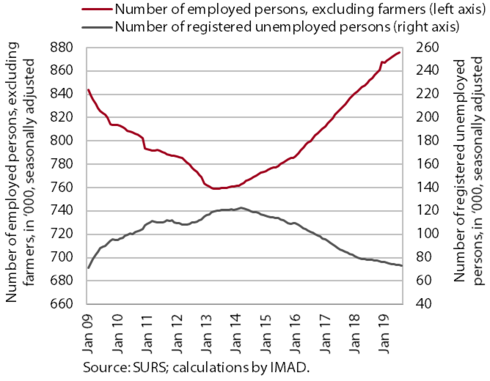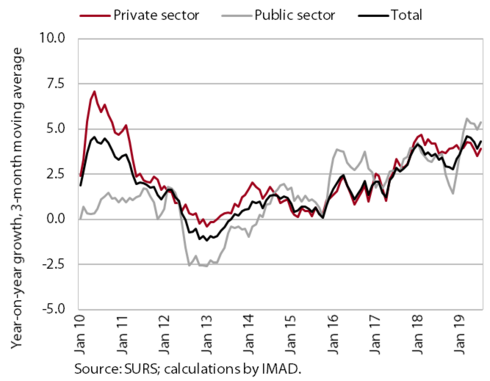Charts of the Week
Current economic trends from 16 to 20 September 2019: labour market, earnings and Slovenian industrial producer prices
Employment growth is slowing, but remains high amid increased hiring of foreigners. Given the low level of unemployment, the falling of the number of unemployed persons eased. Wage growth is strengthening, to a great extent on account of wage growth in the public sector. In the private sector, wages are rising particularly in activities with skill shortages and large shares of minimum wage recipients.
Slovenian industrial producer prices on foreign markets are falling due to the moderation of foreign demand.
Labour market, July – August 2019

Employment growth is slowing, but remains high amid increased hiring of foreigners. In the first seven months the number of the employed increased somewhat less year on year (2.9%) than in the same period of last year (3.3%). The strongest growth was recorded in construction, transportation and storage, accommodation and food service activities and manufacturing, i.e. activities with a high job vacancy rate. The contribution of foreigners to total employment growth remains high, around 70% in July. Amid the already low level of unemployment and the softening of economic activity, the falling of the number of registered unemployed persons slowed in the middle of the year. At the end of August, it amounted to 71,544, which is 5.8% less than one year before.
Earnings, July 2019

Year-on-year wage growth in the first seven months (4.4%) was higher than in the same period of last year (3.6%). The higher growth rate mainly reflects wage growth in the public sector (as a result of the higher valuation of most positions agreed at the end of last year) and promotions. Wage growth in the private sector, amid the still strong GDP growth and upward pressure on wages related to labour shortages, was also due to the increase in the minimum wage at the beginning of the year. This year wages rose the most in accommodation and food service activities, administrative and support service activities, manufacturing and trade, i.e. the sectors with the greatest labour shortages and a high share of minimum wage recipients.
Slovenian industrial producer prices, August 2019

The total year-on-year growth of Slovenian industrial producer prices eased further in August. The moderation was mainly a consequence of accelerated price falls on foreign markets. Producer prices declined across all product groups, according to our estimate also due to slower growth in foreign demand. Price growth on the domestic market remains around 2%, largely owing to strong price rises in energy (on account of higher electricity prices, which record 15% year-on-year growth). Price rises in most other product groups were modest; the highest growth was recorded for prices of non-durable consumer goods (1.8%).
